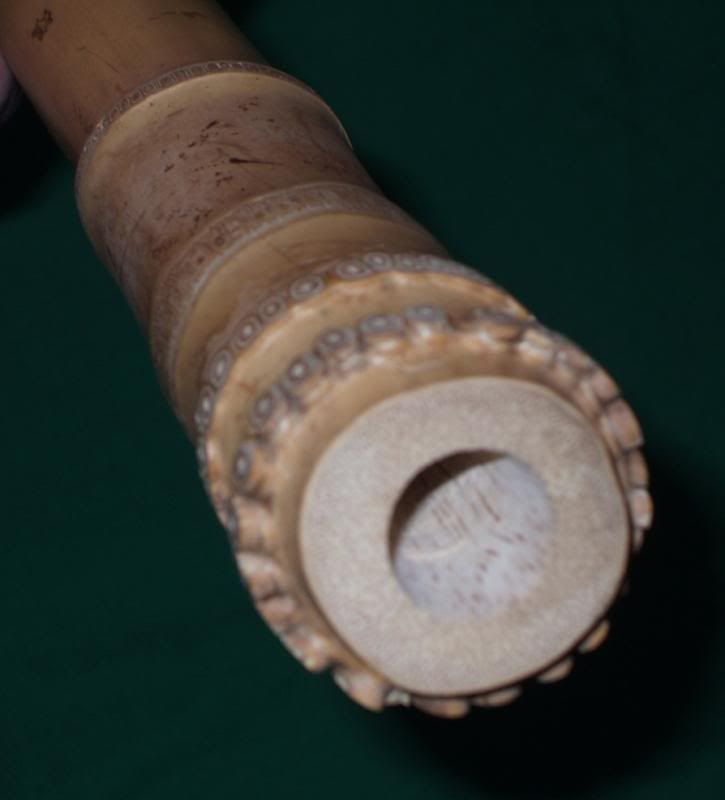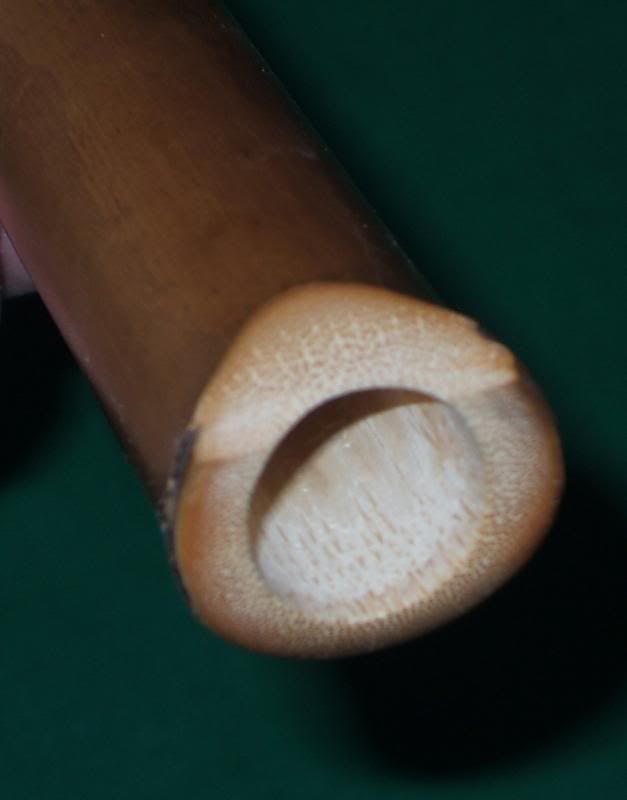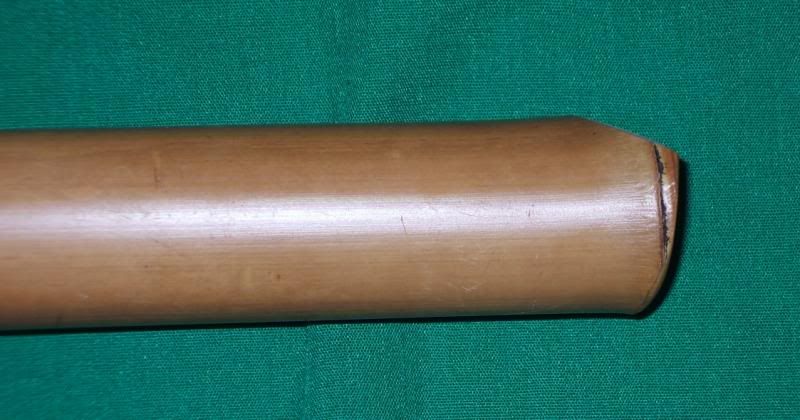Mujitsu and Tairaku's Shakuhachi BBQ
World Shakuhachi Discussion / Go to Live Shakuhachi Chat
You are not logged in.
Tube of delight!
#1 2010-02-09 20:23:37
Octaves out of phase
I am currently working on my first root end jinashi. This is a nice piece that I got from Monty. I have been trying to get the otsu and kan in sync before I start drilling finger holes. Kan is about a semitone flat of otsu. I have been playing around with strips of wet newspaper to try and figure out the problem without any success. I am wondering i what I might do to try and even out the octaves, or should I just go for it and start drilling the finger holes?
Here are some measurements from the flute.
Length : 53.7 cm
Utaguchi diameter : 20 mm. I opened this up a bit since the actual bore of the bamboo was about 19 mm.
Choke point : 15 mm. I used the hand drill that Meijiro sells for opening the root end.
Any ideas as to my next step are greatly appreciated.
Offline
#2 2010-02-09 22:09:00
- Toby
- Shakuhachi Scientist

- From: out somewhere circling the sun
- Registered: 2008-03-15
- Posts: 405
Re: Octaves out of phase
I agree with Jon. Try to get completely rid of the scepta of the nodes, so that you don't have rings of lesser diameter at those points. That is the first step.
If you still have a problem, note that a flat kan means that the area of the bore ~1/2 the distance between the last open tone hole and the top of the utaguchi is too large. In your case this would mean the point just slightly beyond the midpoint of the flute. Of course this also means that the area above must also be filled proportionately so that the taper of the bore is more or less even. Bamboo culms grow differently and have different proportions, and it is not always possible to have a purely jinashi flute in tune. Alternately, you can spend a huge amount of time opening up the whole bottom of the bore, but if the bore is too wide the tone and response of the flute will suffer, even if it is in tune.
Toby
Last edited by Toby (2010-02-09 22:12:07)
Offline
#3 2010-02-09 23:01:16
Re: Octaves out of phase
There can be many variables at work here, but it's good to exhaust the more obvious simple fixes first. Does the bore profile follow a known taper more or less, or as Jon mentions, is the choke point and beyond opened enough? Any other obvious node closures? Is there a node between the third and fourth hole?
Are you playing ro kan with a sliver of the fourth or fifth hole open? That will sharpen it a bit. Also, are you playing ro kan with enough power?
Sometimes, ro octave pitch problems are the result of one half of the bore being too big or too small. More information about that here: http://www.shakuhachiforum.com/viewtopic.php?id=1333
That's a tough break on a first tapered bore attempt. Sometimes, ro and ro kan fall in place nicely on a jinashi piece. When it doesn't, sometimes it can be easily fixed. Other times not.
One option if the simple fixes don't work is to move on to the next flutes that offer better tuning and work them through. Then, come back to the problem flute with a keener eye. You don't have to swing at the first pitch!
Good luck!
Ken
Offline
#4 2010-02-09 23:35:03
Re: Octaves out of phase
Thanks for the responses. I have the nodes cleared out pretty well, however I did just notice that the area just above the node that will fall between the 2nd and 3rd holes widens out fairly dramatically. I think I will try and get some wet newspaper down there and see how it responds.
I have some more root end pieces on the way from James in China, so I will have some other pieces to play with if I can't get this one to behave.
What are some good Ji alternatives? Can I mix some sort of glue with bamboo dust?
Offline
#5 2010-02-10 04:27:27
- Toby
- Shakuhachi Scientist

- From: out somewhere circling the sun
- Registered: 2008-03-15
- Posts: 405
Re: Octaves out of phase
Wood putty or car body putty work well.
Offline
#6 2010-02-10 07:11:37
- Yungflutes
- Flutemaker/Performer

- From: New York City
- Registered: 2005-10-08
- Posts: 1061
- Website
Re: Octaves out of phase
Yuusui wrote:
I am currently working on my first root end jinashi. This is a nice piece that I got from Monty. I have been trying to get the otsu and kan in sync before I start drilling finger holes. Kan is about a semitone flat of otsu...
Utaguchi diameter : 20 mm. I opened this up a bit since the actual bore of the bamboo was about 19 mm.
Any ideas as to my next step are greatly appreciated.
Hi Yusui, Enlarging the top and botom end often times raises the pitch of Otsu. You can try a tuning bead on the 1/4 octave points ( both ends) to see Kan will raise in pitch.
As for a quick and easy "Ji" alternative, try water-based wood filler.
Good luck! Perry
"A hot dog is not an animal." - Jet Yung
My Blog/Website on the art of shakuhachi...and parenting.
How to make an Urban Shakuhachi (PVC)
Offline
#7 2010-02-10 10:27:57
Re: Octaves out of phase
I knew about the tuning bead and had completely forgotten about it. I dropped one down the bore this morning to the spot in question and low and behold, the octaves came more into alignment. I had some wood putty in the shop, so I started filling the area. Tonight I will give it a sand and see how the flute is doing. Thank you for all the great suggestions.
I will try to grab some photos tonight also, since there seems to be an interest.
Offline
#8 2010-02-10 10:30:07
Re: Octaves out of phase
Was just writing this as you posted. I'll include it anyway......
You may be aware of this, but just to clarify, and for the sake of the archive, the use of chopsticks, large bamboo pieces, lead and beads on a string are ideal for exaggerating the tone or pitch difference of an addition in a specific area of the bore. It will give you a quick read of a hot spot. From there, folded, wet newspaper will give you a more subtle read of how much or how little needs to be altered.
Realistically, you can use this method to adjust up to 25 or 30 cents either way. Always worth the try. However, if the octave is a semitone off, it suggests there may be more that needs to be done. It's always something! Looks like you're getting closer!
Offline
#9 2010-02-10 21:30:03
Re: Octaves out of phase
Wow, that sure didn't work. I sanded down the putty this evening and now I am close to 3/4 of a note off. Throwing the bead back in the same spot brings kan a full note flat. I am wondering if the upper part of the bore may be too narrow. I opened up the blowing end to 20 mm from something like 18-19 mm. Maybe shortening the length?
I should also point out that it plays much less stably then it did before I filled the gap.
I am curious how you hold the chopsticks in place when testing with them?
Here are some pictures of the bamboo as it stands today.





Offline
#10 2010-02-11 12:31:54
Re: Octaves out of phase
Yuusui wrote:
Wow, that sure didn't work. I sanded down the putty this evening and now I am close to 3/4 of a note off. Throwing the bead back in the same spot brings kan a full note flat. I am wondering if the upper part of the bore may be too narrow. I opened up the blowing end to 20 mm from something like 18-19 mm.
Are you sure you are adding at the quarter points and not at the half-way point?
Yuusui wrote:
I am curious how you hold the chopsticks in place when testing with them?
String, gravity, tape, etc. Whatever works!
You've probably gone through the archives, but there is a lot of information there. You might find something particularly useful which hasn't been covered here. I've just come up for air after wandering through the flutemaking archive all morning. Wow! A lot of bright people there! Here are a few links though there are many more:
http://www.shakuhachiforum.com/viewtopi … 67&p=1
http://www.shakuhachiforum.com/viewtopic.php?id=2609
http://www.shakuhachiforum.com/viewtopic.php?id=1555
Offline
#11 2010-02-11 12:48:29
Re: Octaves out of phase
The spot I was filling in was a divet near the center. I will try out the quarter points a bit tonight.
The archives are amazing. Thanks for posting the links. I will reread them and see what makes more sense now that I have worked a bit more with the bamboo.
Offline
#12 2010-02-11 13:37:46
Re: Octaves out of phase
Yuusui wrote:
The spot I was filling in was a divet near the center. I will try out the quarter points a bit tonight.
Filling in the center will raise ro otsu and create a larger pitch gap between the octaves. Adding at the quarter points will raise ro kan and bring it closer to ro otsu.
Another possibility comes to mind: Adding at the 1/8 point from the top can flatten the first octave and sharpen the kan octave. In other words, it can affect all notes to some degree.
There are some wavelength graphs on Nelson's site which are very helpful to gain an understanding of wavelength pinnacles, their intensity, length and how they overlap for all notes. Worth the study!
Offline
#13 2010-02-11 19:26:39
Re: Octaves out of phase
I have some wood putty drying right now around the 1/8 point. Prior to sanding I am within 10-20 cents. I am sure I will have to apply some more after the first round of sanding, but with that and a bit of removal in the center, I think I am going to be pretty close.
Offline
#14 2010-02-12 06:03:28
- Toby
- Shakuhachi Scientist

- From: out somewhere circling the sun
- Registered: 2008-03-15
- Posts: 405
Re: Octaves out of phase
Yes, my bad. For flat kan you need to make the quarter points smaller not the center point. But I am thinking that you have a different problem. If your top joint diameter is 19mm opening the top to 20 could cause intonation problems top to bottom, flattening the higher modes more than the lower. That is in line with what you report about kan being flat. In fact, your dai-kan will probably be even flatter--you can try overblowing it up another octave and see. Even if you manage to get your ro's in the correct harmonic relationship with local corrections, you are most probably going to have more problems when you add the other notes. It really doesn't make sense, IMO, to try to do local corrections to ro before knowing what the other notes are going to do.
Basically the first 5 cm of the bore should be cylindrical, and then it should taper roughly evenly to the choke point. If you've opened the top up to 20 then it should be 20 a third of the way down the top joint, more or less, and then gradually narrow to the choke point. Otherwise you are going to have a huge mess on your hands, IMO.
It would be good if some other makers here would weigh in, but my suggestion is to drill your fingerholes before you try local corrections. If you are reluctant to do that for some reason, then get a generally decent bore profile which plays your ro's OK first, but do NOT make any correction that changes only a small area of the bore, because chances are that you will find the same problem for the other notes after you drill your holes.
Also, a 15mm choke is really too big if you upper joint diameter is 18-19mm, but I doubt that is the genesis of your flat kan. It could, however, give you problems in the upper kan and dai-kan.
Toby
Last edited by Toby (2010-02-12 06:25:49)
Offline
#15 2010-02-12 07:28:22
Re: Octaves out of phase
Thanks for that info Toby. For some reason I have it in my head that I needed to have the octaves in phase before progressing. If that isn't the case, then I will try and widen out a bit more of the upper end and then start with the finger holes.
Offline
#16 2010-02-12 10:22:18
Re: Octaves out of phase
Yuusui wrote:
Thanks for that info Toby. For some reason I have it in my head that I needed to have the octaves in phase before progressing. If that isn't the case, then I will try and widen out a bit more of the upper end and then start with the finger holes.
For jinashi shakuhachi, adjusting before drilling holes is certainly not the only way to go about it. Things are relative in the bore. The key is in gaining an understanding of what is happening and developing a game plan. In practice, anything that works is a good strategy. As always, any strategy has its strengths and weaknesses.
After more flutes, you'll have a better idea of what you can get away with or how far to go before drilling holes if you choose to go that route. You'll also be able to juggle the bore options to set yourself up for the best and most efficient design for each particular flute. You can weigh these decisions before or after drilling holes.
One danger of doing too much before drilling is running into problems when it's time for the holes. Especially if the bore profile becomes too unusual from adjustment.
An ideal situation is to start with well balanced octaves and a good (known) bore profile. Often, it works out that way naturally. If not, sometimes the bore can be adjusted in a way that mimics a good (known) bore profile.
It's always good to hack at it and make mistakes, but it can also be helpful to move on to more forgiving flutes for awhile and come back to a stubborn flute with more light on the subject.
Offline